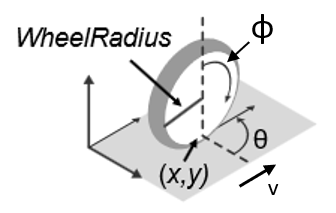unicycleKinematics
Unicycle vehicle model
Description
unicycleKinematics creates a unicycle vehicle model to simulate simplified
car-like vehicle dynamics. The state of the vehicle is defined as a three-element vector,
[x y theta], with a global xy-position, specified in
meters, and a vehicle heading angle, theta, specified in radians. This
model approximates a unicycle vehicle with a given wheel radius, WheelRadius, that can spin in place according to a heading angle,
theta. To compute the time derivative states for the model, use the
derivative
function with input commands and the current robot state.

Creation
Description
kinematicModel = unicycleKinematics
kinematicModel = unicycleKinematics(Name,Value)
Properties
Object Functions
derivative | Time derivative of vehicle state |
Examples
References
[1] Lynch, Kevin M., and Frank C. Park. Modern Robotics: Mechanics, Planning, and Control 1st ed. Cambridge, MA: Cambridge University Press, 2017.
